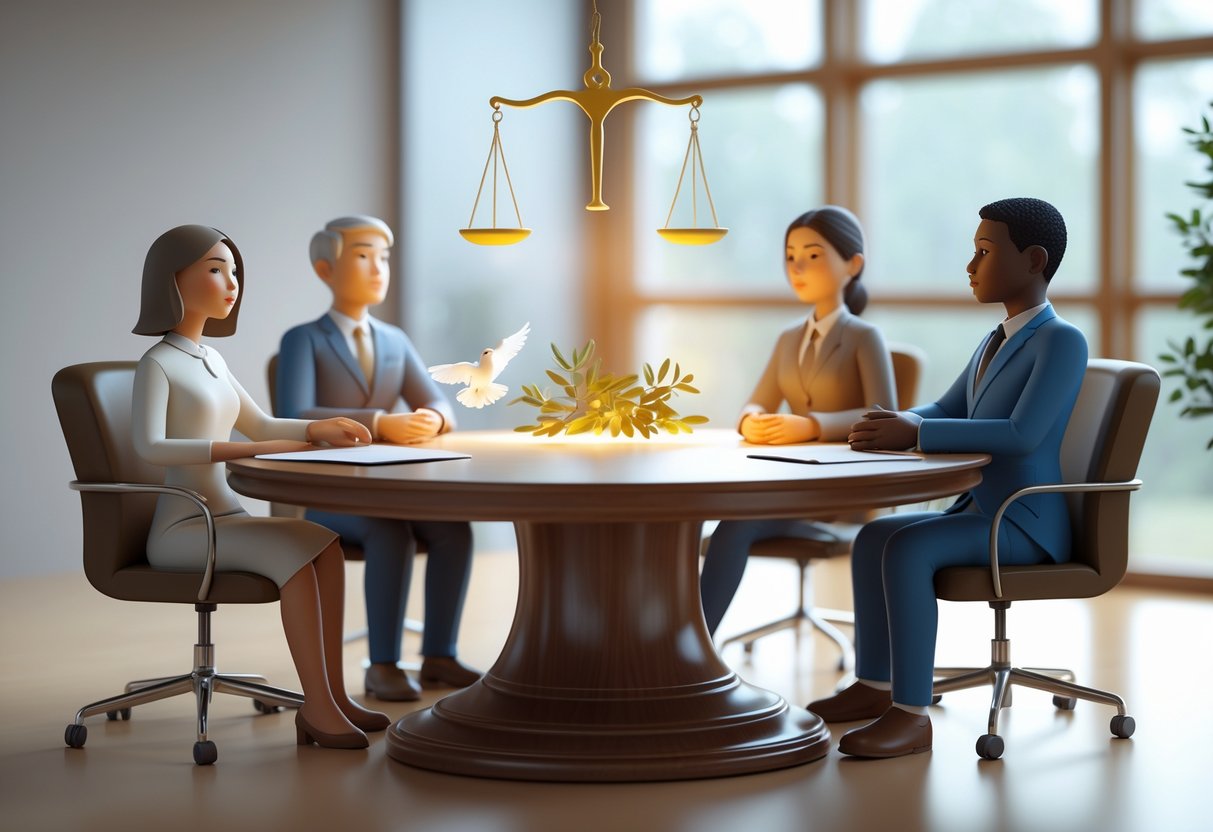Conflict Resolution: Effective Communication and Strategies
Updated On: October 26, 2025 by Aaron Connolly
Understanding Conflict Resolution
Conflict resolution means using practical methods to tackle disagreements and find solutions everyone can live with. These skills let people turn arguments into opportunities for better teamwork or even stronger relationships.
Definition and Objectives
Conflict resolution is really about working through disagreements between people or groups in a positive way. We try to dig into the real reasons behind problems and come up with solutions everyone feels okay about.
The goal? End disputes peacefully. We want to fix relationships and keep the same issues from popping up again.
Key objectives include:
- Finding fair solutions for all sides
- Improving how people talk to each other
- Building trust and understanding
- Stopping future conflicts before they start
When we handle conflicts well, we turn tough moments into chances to learn. This can create better working relationships and tighter teams.
The process is about working together, not beating someone else. Instead of winners and losers, we focus on answers that help everyone.
Key Benefits for Individuals and Organisations
Learning how to resolve conflicts really pays off for people and workplaces. These skills help us deal with disagreements before they blow up.
For individuals, conflict resolution:
- Cuts down on stress and tension at work
- Makes relationships with colleagues smoother
- Builds confidence when things get tricky
- Sharpens communication skills
For organisations, these skills:
- Boost team productivity
- Lower staff turnover
- Save time usually wasted on arguments
- Make the work environment more positive
Companies with good conflict resolution practices see fewer big disputes. Teams get more done when they know how to handle disagreements.
These skills also help stop small issues from turning into big headaches. Jumping in early saves time, money, and sometimes even friendships.
Common Causes of Disputes
If we know why conflicts start, we can stop or solve them faster. Most workplace arguments come from a handful of usual suspects.
Communication problems start a lot of conflicts. Bad listening, confusing instructions, or just different ways of talking can spark misunderstandings.
Resource competition pops up when teams fight for budgets, equipment, or even just enough staff time. When resources are tight, people feel the pressure.
Different values and goals lead to arguments when priorities clash. What matters a lot to one person might not even be on someone else’s radar.
Personality clashes show up when working styles don’t fit. Some folks like it direct, others want a softer touch.
Unclear roles cause trouble when people aren’t sure who’s supposed to do what. Confusion leads to missed tasks, double work, and plenty of frustration.
Types of Conflicts
Conflicts come in all shapes, depending on who’s involved and where they happen. Struggles inside our own heads feel different from arguments with others or big team disputes.
Intrapersonal Conflicts
These conflicts happen inside your own mind when you face tough choices or competing priorities. You might feel torn between what you want and what you think you’re supposed to do.
Common examples include:
- Picking between a safe job and chasing your passion
- Wanting to speak up but worrying about fallout
- Balancing work demands with personal values
Types of internal conflicts:
- Approach-approach: Choosing between two good things
- Avoidance-avoidance: Picking the lesser evil
- Approach-avoidance: Wanting something that also scares you
These conflicts bring stress and uncertainty. If you ignore them, they can mess with your decision-making and your wellbeing.
The trick is spotting when you’re stuck. Try writing out your thoughts or talking things through with someone you trust—it really helps clear your head.
Interpersonal Disagreements
These conflicts pop up between two or more people who just can’t agree on something important. Honestly, they’re the most common kind we deal with every day.
Main sources include:
- Different ways of communicating
- Conflicting needs or interests
- Baggage from past experiences
- Misunderstandings or missing info
At work, these disagreements usually start small but can spiral if left alone. Maybe two coworkers clash over project priorities or feel their work isn’t valued enough.
Relationship conflicts are about personal tension or emotional reactions. Interest conflicts show up when people want different things.
Value conflicts happen when people hold opposite beliefs about what’s right. These can be the trickiest to solve since they run deep.
But here’s a silver lining—if you handle interpersonal conflicts well, relationships can actually improve. You might end up understanding each other better than before.
Group and Organisational Disputes
These are the bigger ones—conflicts that affect whole teams, departments, or the entire company. They’re messier because more people (with different goals) get involved.
Structural conflicts often kick these off. Bad processes, unclear roles, or not enough resources can make groups butt heads. Tight deadlines or teams spread across locations add to the mess.
In the workplace, you might see:
- Departments fighting for the same budget
- Teams with deadlines that don’t match up
- Management decisions that hit groups differently
Data conflicts creep in when groups have different info or see the facts in their own way. Bad assumptions or poor communication can make things explode.
Organisational conflicts need a different touch than personal ones. You’ll need formal steps, good communication, and sometimes changes to systems or structures.
If you ignore these, productivity and morale can take a nosedive. But if you manage them well, they can actually spark positive change and new ideas.
The Conflict Resolution Process
Resolving conflict takes three main steps: figure out the real problem, pick the right way to fix it, and make sure everyone follows through.
Identifying Issues and Root Causes
We have to dig past the obvious argument to get anywhere. That heated talk about missed deadlines might actually come from unclear expectations set long ago.
Start by asking things like, “When did this start bothering you?” or “What would make this better for you?” Let each person share their side without cutting them off.
Listen for patterns:
- When things started going wrong
- Where communication broke down
- Fights over resources
- Clashes in personal values
Most conflicts have layers. The surface fight might be about project ownership, but the real issue could be fuzzy roles or clashing priorities. Write down what you hear from everyone.
Look for what people really need. Someone complaining about meeting times might just want more prep time or clearer agendas.
Choosing the Right Approach
Not every conflict needs the same fix. We have to pick what fits best.
Match your approach to the situation:
| Conflict Type | Best Method | When to Use |
|---|---|---|
| Simple misunderstanding | Direct conversation | Clear communication gap |
| Resource disputes | Negotiation | Limited resources to allocate |
| Deep personality clash | Mediation | Personal relationship breakdown |
| Policy disagreements | Collaborative problem-solving | System or process issues |
For easy stuff, just get people talking in a structured way. If it’s complicated or involves lots of people, you might want a neutral mediator.
Quick tip: If tempers are hot, let everyone cool off first. If the problem is hurting team productivity, jump on it fast. For company policy issues, bring in leadership right away.
Think about who’s involved. Colleagues who see each other every day need to work things out together. People who barely interact might just need clear boundaries.
Implementing Solutions
Agreeing is only half the battle. We have to set clear action steps and make sure everyone sticks to them.
Write down exactly what each person will do differently. Skip vague promises like “communicate better”—try “send project updates every Tuesday by 2 PM” instead.
Key steps:
- Document what everyone agreed to
- Set review dates (every 2-4 weeks is good)
- Watch for early warning signs
- Plan check-in chats
Give someone the job of tracking progress. That could be a manager, HR, or even the people involved. Regular check-ins keep little problems from growing again.
Heads up: Lots of solutions fall apart because people think it’s fixed after one chat. Schedule follow-ups to make sure changes actually happen.
Have backup plans ready. If deadlines slip again, what’s the plan? How will you handle disagreements about the new system? Talking about this now saves headaches later.
Essential Conflict Resolution Skills
Getting good at these basic skills helps teams talk more clearly and find solutions that stick. Strong emotional control, real listening, and reading non-verbal cues are at the heart of resolving conflict.
Patience and Emotional Intelligence
Patience really matters in conflict resolution. When things get tense, our gut reaction is to snap back or get defensive.
If we slow down and try to see things from other viewpoints, we keep little problems from growing. Staying calm—even when others aren’t—is a game changer.
Emotional intelligence helps us:
- Notice when emotions cloud our thinking
- Figure out why someone else is upset
- Keep our voice steady
- Take a break if talks get too heated
We shouldn’t rush to fix things before everyone feels heard. Sometimes, people just want to know you’re listening.
Tips for patience:
- Count to five before replying to criticism
- Ask questions instead of making statements
- Focus on the issue, not the person
- Remember, everyone wants respect
Active Listening Techniques
Active listening means giving someone your full attention. We’re not just waiting to talk or planning our comeback.
Key active listening skills:
- Make eye contact
- Repeat back what you heard to make sure you got it
- Ask follow-up questions
- Don’t interrupt, even if you disagree
Listen to get the real issue, not just what’s on the surface. Sometimes, what people say first isn’t what’s really bugging them.
Phrases that help:
- “Help me understand what you mean by…”
- “So you’re saying…”
- “What would help fix this?”
- “I get why that’s frustrating”
Good listeners skip words like “never” or “always”—those just make things worse. And avoid “you should have” statements that sound like blame.
Body Language Awareness
Our body language speaks volumes, even when we’re quiet. Crossed arms, eye rolls, or turning away can make things worse.
Positive body language:
- Sit or stand at the same level as others
- Keep arms open and hands where people can see them
- Nod to show you’re listening
- Hold eye contact, but don’t stare
Watch for others’ body language too. Someone might say they’re fine, but their posture says otherwise.
Warning signs:
- Clenched fists or stiff posture
- Looking away or checking their phone
- Tapping fingers or fidgeting
- Leaning away from the group
If you spot these, it might be time to pause or ask if everyone’s okay to keep going. Sometimes, a quick break lets people cool off.
Matching your body language to your words builds trust. People can tell when you’re really trying to solve the problem together.
Effective Communication in Conflict Resolution

Good communication sits at the heart of conflict resolution. It’s about saying what you mean, picking up on unspoken cues, and actually connecting through real conversation.
Clear Expression and Transparency
Effective communication really starts when we say what we actually mean. So many conflicts get worse because people just hint at problems instead of calling them out directly.
We can use “I” statements to share our feelings without blaming others. It’s a lot better to say, “I feel frustrated when meetings start late,” than to accuse someone with, “You’re always late to meetings.”
Communication skills get stronger when we:
- State facts before jumping to opinions
- Ask specific questions, not just assume
- Explain why we made certain decisions
- Admit when we don’t understand something
Transparency means sharing info that impacts everyone involved. Hiding details or keeping secret agendas usually blows up in our faces during conflicts.
We can practise clarity by summarising what we’ve heard before we respond. Just repeating back what someone said can stop a lot of misunderstandings from turning into bigger issues.
Nonverbal Communication Cues
Body language can say way more than words, especially during conflicts. Crossed arms, eye-rolling, or turning away sends a negative message—even if our words sound polite.
Positive nonverbal cues include:
- Keeping steady eye contact
- Leaning in a bit to show we care
- Staying open in our posture
- Letting our face match our words
We need to notice when others look uncomfortable or defensive. If someone starts blinking fast, fidgeting, or shifts suddenly, tension might be rising.
Voice tone matters just as much as body language. If we talk too fast, use a harsh tone, or get loud, we can make things worse for no reason.
Active listening shows up in our nonverbal responses too. Nodding now and then or saying “I see” helps people feel genuinely listened to.
Building Rapport Through Dialogue
Strong communication can connect people—even when they’re disagreeing. We build rapport by finding common ground before diving into tough topics.
Opening with shared goals helps everyone cooperate. Most workplace conflicts happen between people who actually want similar things but just don’t agree on how to get there.
We can try these dialogue techniques:
| Technique | Example | Purpose |
|---|---|---|
| Reflecting feelings | “You sound concerned about the deadline” | Shows understanding |
| Asking open questions | “What would help you feel more confident about this?” | Encourages sharing |
| Acknowledging valid points | “You’re right about the budget constraints” | Builds trust |
Effective communication sometimes means knowing when to pause. Not every conflict needs an instant solution—sometimes space helps.
We should hold back from interrupting or planning our comeback while the other person talks. Real dialogue only happens when both sides feel heard and respected.
Major Conflict Resolution Strategies

If you understand the main approaches to conflict resolution, you can pick the right method for each situation. The Thomas-Kilmann model lays out five styles, and collaborative problem-solving gives you a way to find win-win solutions.
The Thomas-Kilmann Model
The Thomas-Kilmann model names five conflict resolution strategies based on how assertive or cooperative you are. Each style fits different situations.
Competing means you push for your own needs and ignore others. This comes in handy when fast decisions are needed or when you’re standing up for something important.
Accommodating puts the other person’s needs first. Use this when the relationship matters more than the issue, or when you realise you’re wrong.
Avoiding means you just stay away from the conflict. Sometimes, that’s best when emotions are high or the issue just isn’t worth it.
Compromising finds a middle ground—everyone gives up something. This helps when you need a quick solution that everyone can live with.
Collaborating goes for solutions that meet everyone’s needs. It takes more time but gives the best results when both the relationship and outcome matter.
Collaborative Problem Solving
Collaboration means working together to find solutions that help everyone. This approach builds trust and stronger relationships while solving problems.
Start by defining what the real problem is. Ask questions to find out what each person actually needs—not just what they say they want.
Brainstorm lots of solutions together. Don’t judge ideas at first—just get them out there. Sometimes, the best options show up unexpectedly.
Key steps include:
- Listening to every perspective
- Finding shared interests
- Creating options that cover everyone’s core needs
- Agreeing on next steps with clear responsibilities
Look at each solution and see how well it fits everyone’s main needs. The strongest collaborative solutions often mix ideas from different people.
Adapting Strategies to Situations
Different conflicts call for different strategies. The trick is matching your approach to the situation.
Think about how important the relationship is. Go with collaboration or accommodation if you want to keep things positive. Use competing only if the relationship can handle it.
Consider how much time you have. Collaboration takes longer but gives better results. Compromising or competing works when you just need something fast.
Power dynamics play a role too. If you have more authority, don’t overuse competing. If you have less, lean on collaboration or accommodation to keep your influence.
Match your approach to conflict intensity. When emotions are running high, sometimes you need to cool off before you can solve things together.
People who handle conflict well adjust their approach depending on these factors, not just out of habit.
Compromise and Collaboration

Both compromise and collaboration help teams get through disagreements by focusing on shared goals instead of personal agendas. These methods build stronger relationships and lead to lasting solutions that everyone can support.
Finding Common Ground
Finding common ground means looking past what people say they want and digging into why they want it. A lot of the time, we get stuck arguing about positions and miss the real needs underneath.
Ask questions that go deeper. “What would success look like for you?” can reveal the real concerns. “What are you hoping to achieve?” shifts the conversation away from demands and toward understanding.
Active listening is huge here. Give your full attention and don’t plan your response while the other person talks. Repeat back what you heard to make sure you got it right.
Look for shared values or goals. Even in heated arguments, there’s usually something both sides want—like hitting a deadline or keeping the team together.
Write down these shared interests where everyone can see them. This keeps everyone focused on the same goals and makes it easier to build solutions.
Negotiation Techniques
Good negotiation starts with preparation and the right attitude. Separate the problem from the people. Focus on fixing the issue, not blaming each other.
Set ground rules before starting:
- No interrupting
- No personal attacks or blame
- Everyone gets a turn to speak
- Focus on solutions, not old mistakes
Use “I” statements to explain your needs without sounding accusatory. Say “I need more time to review this,” instead of “You’re rushing me.”
Brainstorm multiple options before picking one. Come up with different ways to meet everyone’s needs. This creative problem-solving often uncovers options no one thought of before.
Think about when to negotiate. People make better choices when they’re not tired, stressed, or under pressure. Try to talk when everyone can think straight.
Be open to trading different things. Maybe you give up speed to get better quality, or you take on extra work in exchange for more resources.
When to Seek Alternatives
Not every situation works for compromise or collaboration. Sometimes these approaches just take too much time or energy, or people aren’t willing to play fair.
Skip collaboration when:
- You need a decision right now
- The stakes are low and you don’t care about a long-term relationship
- Someone refuses to be honest
- The power gap is too big for a fair discussion
Try other approaches like competing if safety’s on the line, or accommodating if the issue matters way more to the other person.
Sometimes you need outside help. Bring in a neutral mediator if emotions are too high or if you’ve already tried and failed. A fresh perspective can break the deadlock.
Heads up: Don’t push collaboration on people who don’t want it. It just makes things worse and can hurt relationships.
Ask yourself if the relationship is worth the effort. Long-term partnerships deserve more time spent on collaboration than quick, one-off interactions.
Know when to walk away. If someone keeps acting in bad faith or ignores your real needs, you may need to protect your interests in another way.
Handling Workplace Conflict

Workplace conflicts can drag down team performance and stress everyone out. The trick is to catch problems early with clear communication, fair solutions, and building trust among team members.
Preventing Escalation
We can stop most workplace conflicts before they get out of hand. The real secret is spotting tension early and responding fast.
Watch for warning signs like people avoiding each other or suddenly changing how they talk. Folks usually give off small clues before a conflict blows up.
Deal with issues right away when we spot them. Waiting just makes it worse. A quick chat today can avoid a big fight tomorrow.
Try these prevention strategies:
• Set up clear ways for people to raise concerns • Make expectations about respect and behaviour obvious from the start • Hold regular team check-ins to catch issues early • Teach everyone basic conflict resolution skills before trouble starts
Active listening really helps. When people feel heard, they’re less likely to let frustration build up.
We can also schedule conflicts instead of tackling them in the heat of the moment. Say, “This matters—let’s talk it through tomorrow morning,” instead of jumping in while emotions are high.
Resolving Employee Disagreements
When conflicts pop up, we need structured ways to solve them fairly. Different problems need different approaches.
Start with a direct talk between the people involved. A lot of disagreements come from misunderstandings that a clear conversation can fix.
Use this three-step method for emotional conflicts:
- Engage respectfully—watch your tone and body language
- Listen until you really get their side
- Share your own feelings and needs clearly
Try collaborative problem-solving for practical issues:
| Step | Action | Purpose |
|---|---|---|
| 1 | Define core needs | Figure out what each person truly needs |
| 2 | Brainstorm solutions | Come up with options together |
| 3 | Pick mutual solutions | Find what works for everyone |
| 4 | Make an action plan | Assign tasks and deadlines |
| 5 | Follow up | Check progress and adjust as needed |
Bring in neutral mediators if the direct approach doesn’t work. This could be a manager, HR, or an outside mediator.
Fostering a Positive Environment
Strong workplace relationships stop a lot of conflicts before they start. We build this by focusing on culture.
Model respectful communication everywhere. Leaders have to show the behaviour they expect.
Celebrate diversity in thought and background. People who feel valued for who they are tend to clash less.
Create psychological safety so people can speak up. Team members need to feel safe raising issues before they turn into big problems.
Set up fair policies that everyone gets:
• Clear ways to file grievances
• Rules that are enforced the same for everyone
• Regular feedback for improvement
• Recognition for positive behaviour
Invest in relationships with team activities and casual get-togethers. Teams with strong bonds handle disagreements better.
Offer conflict resolution training to everyone—not just managers. Better communication and emotional skills help all staff.
We should also fix systemic problems like unclear roles or not enough resources. Clearing out these issues stops a lot of conflicts from ever starting.
Impartiality and Fairness in Mediation

Staying neutral while balancing different views means mediators need to keep bias in check, challenge their own assumptions, and fairly represent both organisational goals and individual concerns. Patience is essential when working through tricky disputes with lots of stakeholders and competing interests.
Remaining Neutral
Neutrality is the backbone of good conflict resolution in esports disputes. We can’t take sides—not with star players, big organisations, or sponsors.
Key neutrality practices:
- Listen to everyone equally, without cutting them off
- Don’t share personal opinions about gameplay or team choices
- Say no to gifts or favours that could sway us
- Be upfront about any past connections with people involved
Staying neutral doesn’t mean doing nothing. We guide the conversation and make sure everyone gets a fair chance to speak.
Patience matters a lot here. Some esports conflicts involve technical details or contract issues that take time to really understand. If we rush, we risk losing our neutral position.
Addressing Bias and Stereotypes
Unconscious biases often shape how conflicts play out. In esports, people sometimes assume younger players aren’t mature, fall back on gender stereotypes, or show favouritism toward popular streamers.
We have to keep checking our own assumptions. That means questioning first impressions and making sure we give everyone’s perspective a fair shot.
Practical bias-reduction strategies:
- Write down all viewpoints before making up your mind
- Ask questions to clear up confusion instead of guessing
- Change up who speaks first so it’s not always the same person
- Use consistent processes for similar disputes
Gaming culture can reinforce stereotypes about skill, commitment, or professionalism based on who someone is, not what they do. We push back against that by focusing on what people actually do and what they achieve.
Balancing Organisational and Individual Needs
Esports conflicts usually put players and organisations at odds, with personal goals clashing against business needs. Mediators need to understand both sides and avoid taking shortcuts.
Organisations care about their brand, money, and long-term deals. Players want career growth, fair pay, and recognition.
Common organisational concerns:
- Keeping sponsors happy
- Team unity
- Meeting tournament deadlines
- Public image management
Typical individual priorities:
- Fair pay and good contracts
- Credit for achievements
- Career growth
- Building a personal brand
We try to find shared interests. Usually, both sides want to win tournaments, build good community relationships, and have lasting careers. Finding that overlap helps everyone get at least some of what matters most.
Mediation works best when both sides know they matter. No one should get automatic priority.
Common Barriers to Resolution

Poor communication and emotional reactions often block real resolution. Old, unresolved issues can make new problems way harder to tackle.
Miscommunication and Assumptions
When we don’t communicate clearly, conflicts get messier. People often assume they know what others mean without actually checking.
Poor listening skills make disagreements drag on. Too many folks plan their next comeback instead of listening, which just leads to more misunderstandings.
Making assumptions about someone’s motives shuts down real talk. For example, you might think a teammate is slacking off, but maybe they’re just overwhelmed. These bad guesses pile on new problems.
Unclear messages leave everyone guessing. Vague words or missing details make people fill in the blanks themselves, and suddenly everyone’s on a different page.
Active listening techniques help cut through the noise. Restate what you heard, ask questions, and make sure you’re really getting it.
Emotional Reactions
Strong feelings like anger or frustration make it tough to solve anything. When emotions flare, people react instead of thinking things through.
Defensive behaviour pops up when people feel attacked. Instead of fixing the problem, they just try to protect themselves, and both sides dig in.
Anger and frustration can cloud judgment. It gets hard to see the other side or even consider compromise. Quick, emotional reactions usually make things worse.
Fear of confrontation leads people to avoid problems. Small issues pile up and turn into big headaches later. By the time anyone talks about it, things have gotten way out of hand.
Taking a cooling-off period gives everyone a chance to settle down. That way, people can focus on solutions instead of just venting.
Unresolved Past Issues
Old arguments that never got solved can mess with new conflicts. Lingering problems add tension and make everything harder.
Built-up resentment from past fights colours how people see new ones. If someone felt wronged before, they’re likely to expect trouble again, and teamwork suffers.
Pattern recognition makes people brace for the worst if similar situations ended badly before. Sometimes, just expecting a bad outcome makes it happen.
Trust issues from old conflicts make it hard to talk honestly. Without trust, people worry that anything they say will be used against them.
Dealing with root causes of old fights helps clear the air. Sometimes, you need those tough conversations or a fresh start with better ground rules.
Building a Culture of Resolution

If we want real change, we need systems that address problems before they explode. Training, open talk, and leadership buy-in are key for a conflict-ready organisation.
Training and Development
Teams won’t handle conflict well without real training. Basic communication skills just don’t cut it anymore.
Teams need to learn about power dynamics and psychological safety. People have to see how their role affects others and learn to speak up safely.
Identity-based conflict training builds cultural humility. It helps diverse teams work together and avoids misunderstandings based on background.
We should also teach systems thinking and conflict mapping. These tools help teams spot patterns instead of just patching up symptoms.
Training should be ongoing. Regular workshops keep skills sharp, and quick refreshers help too.
Quick win: Try a two-hour workshop on active listening and basic de-escalation.
Encouraging Open Dialogue
Open talk keeps little problems from turning into big ones. We need clear systems so people know how to speak up.
Set up transparent conflict pathways that everyone understands. People should know when to talk things out with a peer and when it’s time to call in a manager or mediator.
Make these pathways visible. Put them on the intranet or on break room walls.
Normalise reflection and repair after conflicts. Hold team debriefs after tough talks. Give people room to acknowledge hurt and rebuild trust.
This encourages learning, not avoidance. Teams get better over time.
Track conflict trends regularly. Watch for patterns by team or department and fix problems before they spread.
Leadership’s Role in Conflict Management
Leaders set the tone, plain and simple. What they do matters more than what they say.
Make conflict resolution a core value. Celebrate tough conversations that lead to progress. Recognise teams who work through tension and come out stronger.
Point out leaders who stay transparent, even when things get tough. This shows that good conflict management gets noticed.
Leaders need to show real commitment to a conflict-resolution culture. When employees see leaders mean it, they actually use the new systems.
Warning: Don’t just sweep conflicts under the rug. That sends the message that problems don’t matter.
Leaders should invest in reflection panels or ombuds programmes. These give people a neutral place to talk things out, without jumping straight to HR.
The real goal? Keep investing in communication and support. Healthier teams, better retention, and stronger collaboration follow.
Frequently Asked Questions

Here are some common questions about resolving disagreements, building conflict management skills, and using techniques like active listening and de-escalation.
What are the recognised steps to effectively resolve a disagreement?
The steps are pretty straightforward. Start by naming the problem and agreeing to work together.
Dig into what’s really driving the conflict—ask about underlying needs, not just surface issues.
Work out a shared vision for fixing things. Try to meet everyone’s core interests, not just split the difference.
Agree on how you’ll keep things on track and check that the solution actually works for everyone.
How can one improve their skills to better manage conflicts?
Practice active listening—don’t plan your reply while the other person is talking. Focus on really understanding their side first.
Regular self-reflection helps spot your own patterns. Maybe you get defensive or tend to avoid tough talks.
Take a mediation or conflict resolution course if you can. Community centres and universities often offer practical classes.
Practice stating your needs without blaming. Use “I” statements instead of “you” accusations.
Could you give examples of how conflicts can be resolved in the workplace?
If team members clash over project priorities, set up a meeting where everyone explains their thinking. Sometimes, just hearing each other out solves the problem.
When departments fight over resources, try collaborative planning. Scheduling together can solve most disputes about shared equipment or rooms.
Personality clashes often fade when roles are clearly defined. Clear boundaries reduce tension.
Communication conflicts usually come from different work styles. Agreeing on how and when to communicate helps a lot.
What strategies are recommended for de-escalating a tense situation?
Lower your voice and slow down when things heat up. People usually match your energy.
Acknowledge emotions, even if you don’t agree. Say something like, “I see this matters to you,” without taking sides.
Take breaks if things get too heated. Coming back after a pause helps everyone think more clearly.
Focus on shared goals. Even in tough moments, there’s usually some common ground to build on.
In what way does active listening contribute to resolving disputes?
Active listening makes people feel heard, so they don’t have to repeat themselves or get louder.
You get more accurate info by listening than by getting defensive. That means you can solve the real problem, not just what you think is wrong.
When you listen well, others usually do the same for you. Most people respond to real attention and respect.
This approach uncovers the real feelings and needs that drive the argument. Often, what someone really cares about isn’t what they first complain about.
What are some exercises or activities that can help in practising conflict resolution?
Role-playing exercises really help us practise tough conversations in a low-pressure way. Grab a friend or colleague and run through a few scenarios before you face the real thing.
Perspective-taking activities push us to see things from another angle. Sometimes, just writing out a disagreement from both sides can show us where we might actually agree.
Communication practice sessions can zero in on skills like using “I” statements or tossing out open-ended questions. Try these out in your regular chats—you’ll get better at them before conflict even pops up.
Mindfulness exercises keep us grounded when talks get tense. A bit of meditation or even simple breathing can make a big difference when emotions start running high.

